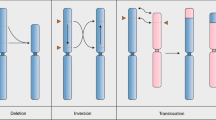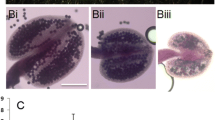Abstract
An unstable allele designated o2-m55, was isolated as a derivative of the o2-m5 allele. Whereas the o2-m5 allele is caused by the insertion of one copy of the transposable element Activator (Ac) into the first exon of the maize Opaque2(O2) gene, the o2-m55 allele contains two Ac elements. The position of one copy is identical to the position of the Ac element in the o2-m5 allele. The second copy is present within the first copy, thereby interrupting its structure shortly before the first ATG of the major reading frame of Ac. Both Ac sequences have the same orientation. Excision of the internal Ac element as well as excision of the complete double Ac element was detectable. Truncated double Ac elements comprising the complete internal Ac element and either the proximal or distal fragment of the interrupted Ac element can also be excised. The Ac elements exhibit a strong negative dosage effect: kernels which display revertant sectors in a mutant background are rarely seen in plants homozygous for the o2-m55 allele. If only one dose of the o2-m55 allele is present in endosperm tissue, revertant sectors can be detected. The amount of the transcript expressed from the internal Ac element of the o2-m55 allele is less than that derived from the single Ac element present in the o2-m5 allele.
Similar content being viewed by others
References
Athma P, Grotewold E, Peterson T (1992) Insertional mutagenesis of the maize P gene by intragenic transposition of Ac. Genetics 131:199–209
Chen J, Greenblatt IM, Dellaporta SL (1992) Molecular analysis of Ac transposition and DNA replication. Genetics 130:665–676
Coupland G, Baker B, Schell J, Starlinger P (1988) Characterization of the maize transposable element Ac by internal deletions. EMBO J 7:3653–3659
Coupland G, Plum C, Chatterjee S, Post A, Starlinger P (1989) Sequences near the termini are required for transposition of the maize transposon Ac in transgenic tobacco plants. Proc Natl Acad Sci USA 86:9385–9388
Courage-Tebbe U, Döring H-P, Fedoroff N, Starlinger P (1983) The controlling element Ds at the Shrunken locus in Zea mays: Structure of the unstable sh-m5933 allele and several reverants. Cell 34:383–393
Dooner HK, Belachew A (1989) Transposition pattern of the maize element Ac from the bz-m2 (Ac) allele. Genetics 122:447–457
Döring H-P (1989) Tagging genes with transposable elements. An overview. Maydica 34:73–88
Döring H-P, Starlinger P (1984) Barbara McClintock's controlling elements: now at the DNA level. Cell 39:253–259
Döring H-P, Starlinger P (1986) Molecular genetics of transposable elements in plants. Annu Rev Genet 20:175–200
Döring H-P, Tillmann E, Starlinger P (1984) DNA sequence of transposable element Dissociation in maize. Nature 307:127–131
Döbring H-P, Garber R, Nelsen B, Tillmann E (1985) Transposable element Ds and chromosomal rearrangements. In: Freeling M (ed) Plant Genetics. Alan R. Liss, New York, pp 355–367
Döring H-P, Nelsen-Salz B, Garber R, Tillmann E (1989) Double Ds elements are involved in chromosome breakage. Mol Gen Genet 219:299–305
Döring H-P, Pahl I, Durany M (1990) Chromosomal rearrangements caused by the aberrant transposition of double Ds elements are formed by Ds and adjacent non-Ds sequences. Mol Gen Genet 224:40–48
English J, Harrison K, Jones J (1993) A genetic analysis of DNA sequence requirements for Dissociation Sate I activity in tobacco. Plant Cell 5:501–514
Fedoroff NV (1983) Controlling elements in maize. In: Shapiro JA (ed) Mobile genetic elements. Academic Press, New York, pp. 1–63
Fedoroff NV (1989) Maize transposable elements. In: Berg DE, Howe MM (eds) Mobile DNA. American Society for Microbiology, Washington, DC, pp 375–411
Greenblatt IM (1974) Movement of Modulator in maize: a test of an hypothesis. Genetics 77:671–678
Greenblatt IM (1984) A chromosome replication pattern deduced from pericarp phenotypes resulting from movements of the transposable element, Modulator, in maize. Genetics 108:471–485
Greenblatt IM, Brink RA (1962) Twin mutations in medium variegated pericarp maize. Genetics 47:489–501
Hartings H, Maddaloni M, Lazzaroni N, DiFonzo N, Motto M, Salamini F, Thompson R (1989) The O2 gene which regulates zein deposition in maize endosperm encodes a protein with structural homologies to transcriptional activators. EMBO J 8:2795–2801
Heslop-Harrison JP, Bennett MD (1990) Nuclear architecture in plants. Trends Genet 6:401–405
Kermicle JL, Alleman M, Dellaporta SL (1989) Sequential mutagenesis of a maize gene, using the transposable element Dissociation. Genome 31:712–716
Korfhage C, Döring H-P (1990) Chromosome breakage at the Ds-induced sh-m6233 allele. Maize Genet Coop Newslett 64:42
Krawallek C (1991) PhD thesis, Universität zu Köln, Germany
Kunze R, Starlinger P (1989) The putative transposase of transposable element Ac from Zea mays L. interacts with subterminal sequences of Ac. EMBO J 8:3177–3185
Kunze R, Stochaj U, Laufs J, Starlinger P (1987) Transcription of transposable element Activator (Ac) of Zea mays L. EMBO J 6:1555–1563
Lechelt C, Peterson T, Laird A, Chen Y, Dellaporta SL, Dennis E, Peacock WJ, Starlinger P (1989) Isolation and molecular analysis of the maize P locus. Mol Gen Genet 219:225–234
Maddaloni M, Di Fonzo N, Hartings H, Lazzaroni N, Salamini F, Thompson R, Motto M (1989) The sequence of the zein regulatory gene opaque-2 (O2) of Zea mays. Nucleic Acids Res 17:7532
McClintock B (1948) Mutable loci in maize. Carnegie Inst Wash Yearbook 47:155–169
McClintock B (1951) Chromosome organisation and genic expression. Cold Spring Harbor Symp Quant Biol 16:13–47
Moreno MA, Chen J, Greenblatt I, Dellaporta SL (1992) Reconstitutional mutagenesis of the maize P Gene by short-range Ac transpositions. Genetics 131:939–956
Motto M, Maddaloni M, Ponziani G, Brembilla M, Marotta R, Di Fonzo N, Soave C, Thompson R, Salamini F (1988) Molecular cloning of the o2-m5 allele of Zea mays using transposon marking. Mol Gen Genet 221:488–494
Müller-Neumann M, Yoder J, Starlinger P (1984) The DNA sequence of the transposable element Ac of Zea mays L. Mol Gen Genet 198:19–24
Peterson T (1990) Intragenic transposition of Ac generates a new allele of the maize P gene. Genetics 126:469–476
Piatkowski D, Schneider K, Salamini F, Bartels D (1990) Characterization of five abscisic acid-response cDNA clones isolated form the desiccation-tolerant plant Craterostigma plantagineum and their relationship to other water-stress genes. Plant Physiol 94:1682–1688
Pohlman R, Fedoroff N, Messing J (1984) The nucleotide sequence of the maize controlling element Activator. Cell 37:635–643
Ralston E, English J, Dooner HK (1989) Chromosome-breaking structure in maize involving a fractured Ac element. Proc Natl Acad Sci USA 86:9451–9455
Robbins TP, Carpenter R, Coen ES (1989) A chromosome rearrangement suggests that donor and recipient site are associated during Tam3 transposition in Antirrhinum majus. EMBO J 8:5–13
Saedler H, Nevers P (1985) Transposition in plants: a molecular model. EMBO J 4:585–590
Saghai-Maroof X (1984) Ribosomal spacer length polymorphisms in barley: Mendelian inheritance, chromosomal location and population dynamics. Proc Natl Acad Sci USA 81:8014–8018
Sambrook J, Fritsch EF, Maniatis T (1989) Molecular cloning: a laboratory manual. Cold Spring Harbor Laboratory Press, Cold Spring Harbor, New York
Schmidt RJ (1993) Opaque-2 and zein gene expression. In: Verma DPS (ed) Control of Plant Gene Expression. CRC Press, Boca Raton, pp 337–355
Schmidt RJ, Burr FA, Burr B (1987) Transposon tagging and molecular analysis of the maize regulatory locus opaque-2. Science 238:960–963
Sutton WD, Gerlach WL, Schwartz D, Peacock WJ (1984) Molecular analysis of Ds controlling element mutations at the Adh1 Locus of maize. Science 223:1265–1268
Van Schaik NW, Brink RA (1959) Transposition of Modulator, a component of the variegated pericarp in maize. Genetics 44:725–738
Varagona M, Wessler SR (1990) Implications for the cis-requirements for Ds transposition based on the sequence of the wxB4 element. Mol Gen Genet 220:414–418
Weck E, Courage U, Döring H-P, Fedoroff N, Starlinger P (1984) Analysis of sh-m6233, a mutation induced by the transposable element Ds in the sucrose synthase gene of Zea mays. EMBO J 3:1713–1716
Weil CF, Wessler SR (1993) Molecular evidence that chromosome breakage by Ds elements is caused by aberrant transposition. Plant Cell 5:515–522
Weil CF, Marillonet S, Burr B, Wessler SR (1992) Changes in state of the Wx-m5 allele of maize are due to intragenic transposition of Ds. Genetics 130:175–185
Author information
Authors and Affiliations
Additional information
Communicated by H. Saedler
Rights and permissions
About this article
Cite this article
Michel, D., Salamini, F., Motto, M. et al. An unstable allele at the maize Opapue2 locus is caused by the insertion of a double Ac element. Molec. Gen. Genet. 243, 334–342 (1994). https://doi.org/10.1007/BF00301069
Received:
Accepted:
Issue Date:
DOI: https://doi.org/10.1007/BF00301069




